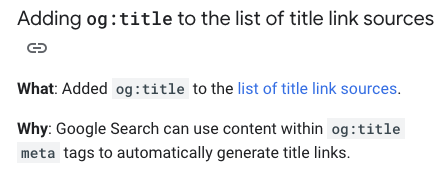In an update to its search documentation, Google has expanded the list of sources it uses to generate title links in search results.
Google now includes the og:title meta tag as one of the elements it considers when automatically creating title links for web pages.
 Screenshot from: developers.google.com/search/updates, August 2024.
Screenshot from: developers.google.com/search/updates, August 2024.Title links, which appear as clickable headlines for search results, give people a quick introduction to a webpage and how well it matches their search.
Google’s system for generating title links has long relied on various on-page elements. Adding og:title expands the list of criteria Google uses.
Understanding og:title
The og:title tag allows you to specify a title for your content that may differ from the traditional HTML title tag. This can be useful for optimizing how a page appears when shared on social networks or, now, in search results.
Og:title is part of the Open Graph protocol, a set of meta tags developed by Facebook that allows any page to become a rich object in social graphs.
While it’s used to control how content appears on social media platforms, Google’s inclusion of this tag in its title link sources indicates a broader use of Open Graph data.
Impact On SEO & Content Strategy
With this update, you may need to pay closer attention to og:title tags, ensuring they accurately represent page content while remaining engaging for searchers.
Google’s documentation now lists the following sources for automatically determining title links:
- Content in
elements - Main visual title shown on the page
- Heading elements, such as
- Content in og:title meta tags
- Other large and prominent text through style treatments
- Other page content
- Anchor text on the page
- Text within links pointing to the page
- Website structured data
While Google says its title link generation is automated, understanding the sources it uses can help you influence how pages appear in search.
Best Practices Remain Unchanged
Google’s best practices for title links remain largely unchanged. The company recommends creating unique, descriptive titles for each page, avoiding keyword stuffing, and ensuring titles accurately reflect page content.
Note that changes to these elements may take time to be reflected in search results, as pages must be recrawled and reprocessed.
Featured Image: Sir. David/Shutterstock
